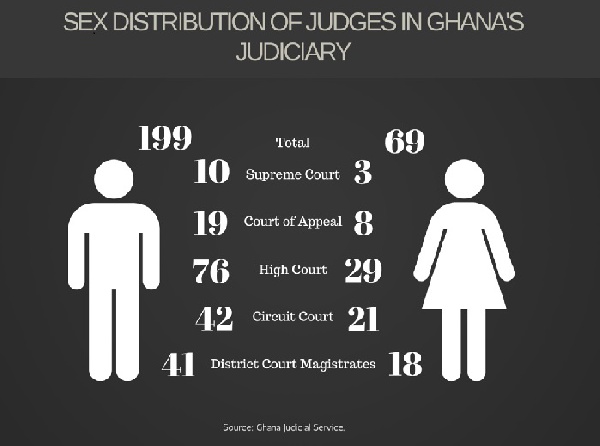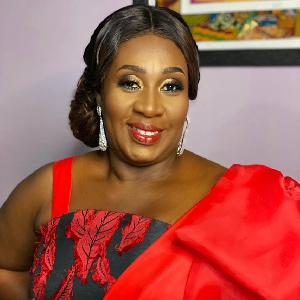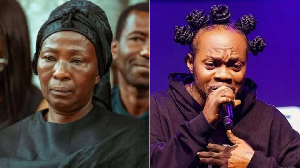Anas Aremeyaw Anas’ release of material evidence of corruption within Ghana’s judicial system raises important questions about the sanctity of the country’s rule of law. For many Ghanaians, the judicial scandal is only a sneak peek into an infesting rot in the three arms of government that has resulted in gross mismanagement of the nation. The scandal however presents some ray of hope.
Public commitment to the fight against corruption has been revitalised, making a compelling case for an open-minded populace who will critically engage with all possible anti-corruption strategies to explore potentials for reform.
“Progress is impossible without change, and those who cannot change their minds cannot change anything.” – George Bernard Shaw
In the absence of careful, factual analysis of issues within a context of what looks like the worst scandal in the history of Ghana, assertions that corruption levels in Ghana would reduce if more women rise to power suffers outright rejection. But Anas’ investigative method and findings throw a dim light on some important questions that provides some motivation to look into the correlation between sex and corruption in Ghana. Are women in power less corrupt than their male counterparts? How do these play out in redefining female participation in the three arms of Government?
The objective of this article is to bring a fresh perspective in the fight against corruption through sex mainstreaming, using facts. In an attempt to answer these questions, this article departs from a loose intuitive acceptance of the prima facie findings of Anas’ investigation to a factual analysis of sex and corruption issues in Ghana based on his methodology and findings, alongside empirical evidence, data and cross country comparison. The first part of this article therefore explores the moral ambivalence among men and women to test the hypothesis that women are less ‘evil’ than men.
The second part of the article analyses Anas’ methodology and findings to explain that the sex gap in Ghanaian leadership likely affects its corruption levels. In the last section, we show that steps taken by other countries to balance the sexes in leadership has had positive impacts on corruption levels and that should Ghana take a similar path, issues of corruption may gradually become a thing of the past. It is important to note that this article is an attempt to add on to existing efforts to reduce corruption levels in Ghana.
PART ONE
Moral ambivalence: Are women less susceptible to corruption than men?
Globally, there are more men in prison than women, and there are more women in churches than men. These statements give an intuitive impression that women are generally more disposed to do right than men, including not condoning corrupt practices. This assertion is however anecdotal. A turn to empirical research thus becomes necessary.
According to the United Nations Office on Drugs and Crime (UNODC), corruption is a transnational crime. Criminology literature shows that men are more likely to commit offenses than females (Gottfredson & Hirschi, 1990 cited in Rivas 2008). Additionally, crimes committed by males are more serious than females. A possible explanation to this phenomenon could be that woman are more averse to risk-taking than men when facing comparable incentives (Jianakoplos and Bernasek 1998; Watson and McNaughton 2007). Clinical and field studies in Psychology, Behavioural Science and Economics substantiate views about the negative correlation between women and corruption.
A laboratory experiment on corruption and sex by Rivas (2008) disclosed that women are less corrupt than men. This confirms Torgler and Valev’s (2006) findings that women are less likely to agree that corruption and cheating on taxes can be justified. Meta-analytical studies in Economics literature also suggest that women are less accepting of dishonest behaviour, and that there exists a negative relationship between women’s participation rate in politics and corruption level.
Dollar et al. (2001) and Swamy et al. (2001) studied the acceptability of corrupt behaviour by men and women and the relationship between women’s participation rate in politics and corruption.
Analysing data from more than 100 countries, Dollar et al. (2001) found a strong negative and statistically significant relationship between the level of female participation in politics measured by the percentage of seats occupied by women in the lower and upper chambers and a corruption index (the International Country Risk Guide index). Their conclusion is that encouraging women to have a higher political participation may be beneficial to society.
Using different data sources, Swamy et al. (2001) studied the hypothesis that female participation in government would reduce corruption. Using the World Value Surveys (WVS) they found that women are less tolerant towards dishonest or illegal activities than men. The second data set they used is an enterprise survey conducted in Georgia, where firm owners and managers were asked the following question: "How frequently do officials providing services require unofficial payments?”.
The evidence they found suggests that men are more frequently involved in corruption than women. With the third data set using cross-country data, they found that corruption is less prevalent where women carry more weight in politics and in the labour force, in line with Dollar et al. (2001).
One would think that women have a natural inclination to shun corruption. Further research by Frank, Lambsdorff and Boehm (2011) reveal, however, that “women are not necessarily intrinsically honest or averse to corruption than men.” Rather, their susceptibility to corruption hangs on institutional and cultural contexts (Alatas, Cameron and Chaudhuri, 2009). The context that ensures the incorruptibility of women is democratic, where the barks of the rule of law correspond with its bite.
This context puts a significant pressure on women politicos to conform to established political norms about corruption. Moreover, women are more vulnerable to punishment for violating political norms because of “explicit or tacit sex discrimination” (Stolberg, 2011). This position has been confirmed by a 2013 political science research from Rice University titled ‘Fairer Sex or Purity Myth? Corruption, Sex and Institutional Context.’ According to Esarey, the study’s lead author, "The relationship between sex and corruption appears to depend on context...When corruption is stigmatized, as in most democracies, women will be less tolerant and less likely to engage in it compared with men…”
Based on empirical studies discussed, it can be theorised that corruption levels will fall if there are more women in power because women in power are less corrupt than men especially in democratic contexts where corruption is stigmatised. This, in other words, means that a democratic society with otherwise more men at the helm of affairs is likely to be more corrupt.
PART TWO
What Anas’ investigation reveal about the moral ambivalence of the sexes in Ghana.
Anas’ investigation of corruption in Ghana’s Judiciary has generated an unintended positive effect. It signals sex (male and female) imbalance in Ghana’s top-level governance structure; the correction of which will help Ghana self-address the problem of corruption.
Central to this analogy is the fact that Anas’ investigation confirms the theory deduced from empirical evidence in part 1 that a democratic society, like Ghana, with more men at the helm of affairs than women is likely to be more corrupt.
Methodology and Findings
First of all, the investigation presents in numerical terms the reality that there are more male than female judges and magistrates in Ghana.

Our research indicates that Anas and his team adopted the purposive sampling technique to select judges for their investigation. They began with the question: “Who are the judges with reputation for corruption[1]?” Based on the list circulated by news agencies of the 34 indicted judges and 11 ‘loyal’ judges, we assumed that a total of 45 judges were purposively sampled for the investigation, based on their perceived reputation for corruption.
The second basis for the sample size assumption has to do with the investigators’ expectation for a binary response from the selected judges to either succumb or not succumb to corrupt practices. It is impossible to have responses that do not conform to either of the investigators’ expectations.
Of the 45 judges and magistrates sampled, only 6 were female. This is a reflection of the sex imbalance within Ghana’s entire Judiciary. Ghana’s judicial system is male-dominated. Out of a total of 268 judges and magistrates, there are 199 men representing 74% compared to only 69 females, representing 26%.

We also gather from the Ghana Judiciary Service website a sample frame of 227 judges at the High, Circuit and District Court levels from which the investigation sample was selected. Female judges and magistrates are not up to one-third of this sample frame. In other words, the ratio of women to men is 1 to 3.
Secondly, Anas’ purposive sampling method provides some degree of certainty that corruption indeed exists in the judiciary, which is highly perceived by the general public but a glaring, open truth to most workers within the judicial system. The sampling method also debunks claims that judges fell for a one-time allurement.
As explained earlier, these judges and magistrates were highly perceived for their susceptibility to corruption. The female judge who refused bribes from the Tiger Eye team in the first instance but accepted on the second instance speaks to this fact.
Thirdly, behind a veil of ignorance about the sex gaps within Ghana’s judiciary, one would merely acknowledge the presence of corruption in Ghana’s Judiciary without assigning weight to the extent to which men in the judiciary are more susceptible to corrupt practices than their female counterparts.
It is important however to appreciate that the sampling of the 45 judges and magistrates was based on a foreknowledge that they were perceived to be corrupt. Out of these were 39 males. Anas’ investigation further indicted more men than women for corruption. From the sample size of 45 judges, 76% were caught on camera taking bribes. Only 5% were females; the remaining 71% of the total number of judges sampled were males.

From the infograph above, the proportion of women that took bribe (5%) is lesser than the proportion that did not (9%). Conversely, the proportion of men that took bribes (71%) is greater than –and more than quadruples- the proportion of men that refused bribes (15%). This distribution provides some understanding that women are corrupt but not as much in numbers and extent as men would be.
Ghana’s legislature and executive wings are also male-dominated and equally perceived by the general public to be corrupt. There are currently only 30 females in a 275-seat parliament, and only 9 in ministerial positions out of 39 state ministers. Following Anas’ exposé, the Minority Leader of the Parliament of Ghana disclosed that “The judiciary is not made up of saints just as those of us in parliament; equally so for the executive; even the presidency. We shouldn’t be kidding ourselves; times are hard and if you are not careful you may overstep your bounds to engage in otherwise illegalities to be able to survive. But that should not be justified in anyway.” This statement clearly links corruption to economic hardships. In a country where men seem to generally bear greater financial responsibilities than women, more men are likely to engage in corrupt practices.
Based on the theory deduced from empirical evidence and the fact that Ghana’s judiciary, legislative and executive arms of government are male-dominated, it can be concluded that existing corruption levels far exceed general knowledge. Anas’ investigations however give hope that not all judges –and by extension, politicians/public servants- are corrupt, and that not all perceptions are true. Some purposively sampled judges – who were perceived to be corrupt – actually refused bribes. It is worthy to note however that most of the judges that refused bribes were new in their positions.
This signals that employees are more likely to hold high moral integrity in their new roles, until time reveals their preferences. The asymmetry of information between principals (citizens) and agents (public servants) presents a moral hazard that can properly be addressed through the right incentives and internalisation of nationalism. An important lesson here is that no public official – particularly MPs and Ministers – should stay longer in their assigned portfolio. The power of the citizen’s vote must emanate from purpose, not ties.
Anas’ investigation thus provides the subtle insight that to purge the Judiciary, Legislature and the Executive arms of government of corruption and restore their integrity, efforts to increase the number of female judges and magistrates, legislators and ministers should be considered and taken seriously among a list of alternatives. Anas’ investigation essentially provides a solution in disguise to Ghana’s corruption problem.
PART THREE
Rethinking Women Participation in governance for corruption reduction in Ghana: A Cross-Country comparison
According to the 2015 World Justice Project (WJP) corruption index, Ghana ranks 59th of 102 countries behind African countries like Botswana, Senegal, South Africa, Morocco, and Ethiopia. While these countries improved their ranking from previous year by a difference of 5 on average, Ghana only improved by 1. Transparency International’s recent Corruption Perception index (CPI) also ranks Ghana 61st behind Botswana, Cape Verde, Seychelles, Mauritius, Lesotho, Namibia and Rwanda.
Interestingly, most of these better-ranking countries have more women in politics compared to Ghana.
The 2015 Women in Politics mapping by Inter-Parliamentary Union indicates female parliamentarians in Ghana constitute only 10.9% compared to Namibia’s 28.2%, Seychelles’ 43.8% South Africa’s 40.7% and Rwanda’s 57.1%. While Ghana has 23.1% women in ministerial positions, women in ministerial positions in Cape Verde and Rwanda constitute 52.9% and 35.5% respectively of the total number of ministers. Rwanda in particular provides inspiring example for gender parity in the fight against corruption for development.
Rwanda’s Parliament is considered the most female-friendly national legislature in the world. Fourteen years after the genocide, Rwanda elected the world’s first women-dominated legislature in 2008. Women in parliament currently exceed the 30 percent constitutional representation for women. Women also grabbed one-third of all cabinet positions as well as the plum jobs of Supreme Court chief and speaker of parliament.
According to Transparency International, Rwanda remains the least corrupt country in East Africa and has stayed among the five best performers in Africa in fighting corruption. By putting in place institutional and legal frameworks, the female-dominated Government of Rwanda has demonstrated political will to promote good governance and zero tolerance for corruption. Public trust in government has increased, leading to positive impacts on the economy. Increased women participation in governance has increased Rwanda’s commitment to transparency, thereby reducing corruption.
Corruption is one of the major seemingly insurmountable issues that undermine public policy and development efforts in Ghana at all levels and in all sectors, both formal and informal. It has had corrosive effects on the nation’s economic growth, business operations, poverty reduction efforts and the overall regulatory environment through its impacts on investment, taxation, public expenditures and human development. By distorting incentives and the decision-making process, the blight of rent-seeking behaviour has rendered state institutions highly inefficient.
The global discourse about corruption reduction tends to lay more emphasis on transparency and democracy ideals, and less on the human factors that shape these ideals. Bribery and corruption has been characteristic of Ghana’s male-dominated governance systems throughout history, confirming empirical evidence that men are more susceptible to corruption in politics than women.
Women’s low participation in governance in Ghana, especially in parliament, has been due to issues of culture and traditions, women’s multiple burdens in society, lack of resources, low self-esteem and self-confidence, low socio-economic status, unfavourable electoral systems, absence of affirmative action legislation, lack of party support, male-dominated working pattern in parliament, etc.
For Ghana’s performance on corruption to rapidly improve, lessons should be drawn from Rwanda’s experiences. Women’s participation in governance should receive strong national attention. Without undermining the valid women-centred empowerment and equality arguments in favour of gender parity in public and political life, this article more importantly reinforces a public good/nation-centred argument, so that stakeholders do not take actions to increase women representation merely to close numerical gaps, but that they appreciate the role of women in achieving transparency and good governance.
CONCLUSION
Anas’ exposé is just one step towards corruption eradication. More important to Anas’ findings is the subtle insight on how sex (male/female) balance in governance could be the way forward. Empirical evidence shows that in democratic societies where corruption is stigmatised, putting more women in power will reduce corruption levels. Ghana is a democracy that has become corruption intolerant in recent years. Anas and his Tiger Eye team’s past and recent undercover investigations, coupled with the rise of activism in Ghana continually mount pressure on government to be more accountable.
The window of opportunity is now, to openly advocate for women to participate in public service. Efforts should go beyond passing women-centred affirmative action bill to merely close numerical gaps. The general public should be sensitized to understand that women are intrinsically needed for nation-building and that every attempt made to bring women to the helm of affairs is not a ‘misconstrued’ feminist move, but a positive move towards a corruption-free country.
About Authors
Pauline Anaman is an alumnus of the Blavatnik School of Government, University of Oxford (2014), and the Department of Land Economy, KNUST (2012). She is passionate about public sector management and natural resource governance for social progress and economic development.
Ernest Armah is the Head of Programs and Social Policy at IMANI Center for Policy and Education.
References
Agutamba, K. (2014). Rwanda graft index falters but ranking unaffected. The New Times. Retrieved from http://www.newtimes.co.rw/section/article/2014-12-04/183704/
Baneseh, M. A. (2015, September 10). Judicial bribery: 12 High Court Judges to face impeachment. Daily Graphic. Retrieved from http://graphic.com.gh/news/general-news/49193-judicial-bribery-12-high-court-judges-to-face-impeachment.html
Bribery scandal in Judiciary: No Judge discharged, official list now out. (2015, September 14). Daily Graphic. Retrieved from http://graphic.com.gh/news/general-news/49391-bribery-scandal-in-judiciary-no-judge-discharged-official-list-now-out.html
Esarey, J. (2013). Women in Politics less likely to be corrupt. ScienceDaily. Retrieved from http://www.sciencedaily.com/releases/2013/09/130912143942.htm
Ghosh, P. (2012). Rwanda: The Only Government in the world dominated by women. International Business Times. Retrieved from http://www.ibtimes.com/rwanda-only-government-world-dominated-women-213623
Judges and Magistrates. (2015). Judicial Service. Retrieved from http://www.judicial.gov.gh/index.php/judicial-officers/supreme-court-judges
Judicial scandal - Newsfile on JoyNews. (2015, September 12). Retrieved from https://www.youtube.com/watch?v=UJsoEJgrA4I
List of countries and dependencies by population. Wikipedia. Retrieved from https://en.wikipedia.org/wiki/List_of_countries_and_dependencies_by_population
List of MPs By Gender. (2015). Ghana MPs: 5th and 6th Parliament listing. Retrieved from http://www.ghanamps.com/mps/index.php?page=gender
Mould-Iddrisu, B. (2010, November 29). Towards increased women’s participation and representation in Parliament. Retrieved from https://bettymould.wordpress.com/2010/11/29/%E2%80%98towards-increased-women%E2%80%99s-participation-and-representation-in-parliament%E2%80%99/
Owusu, W. Y. (2015, September 11). Bribery scandal: 34 Judges exposed. Daily Guide. Retrieved from http://www.dailyguideghana.com/bribery-scandal-34-judges-exposed/
Quist, E. (2015, September 12). Judicial Heroes: Anas releases names of 11 Judges who refused bribe. Pulse. Retrieved from http://pulse.com.gh/news/judicial-heroes-anas-releases-names-of-11-judges-who-refused-bribe-id4162419.html
Rivas, M. F. (2008). An experiment on corruption and gender.
Transparency International. (2007). Gender and corruption: are women less corrupt? Retrieved from http://www.transparency.org/news/pressrelease/gender_and_corruption_are_women_less_corrupt
Transparency International. (2015). Corruption Perceptions Index-2014. Retrieved from https://www.transparency.org/cpi2014/results#myAnchor1
We’re not saints in parliament, just like the Judiciary - Minority Leader. (2015, September 16). CitifmOnline. Retrieved from http://citifmonline.com/2015/09/16/were-not-saints-in-parliament-just-like-the-judiciary-minority-leader/
World Justice Project. Rule of Law Index 2015. Retrieved from http://worldjusticeproject.org/sites/default/files/roli_2015_0.pdf
Opinions of Thursday, 1 October 2015
Columnist: Anaman Pauline & Armah Ernest















